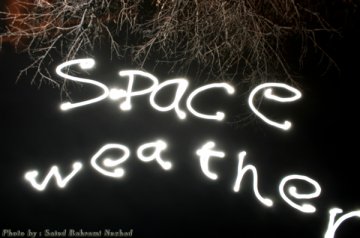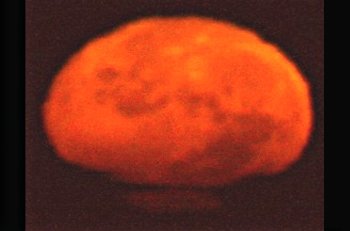 Where's Saturn? Is that a UFO--or the ISS? What's the name of that star? Get the answers from mySKY--a fun new astronomy helper from Meade. Where's Saturn? Is that a UFO--or the ISS? What's the name of that star? Get the answers from mySKY--a fun new astronomy helper from Meade. FLYING MOONDUST: New research by NASA scientists shows that moondust kicked up by the jets of lunar landers can go on a fantastic journey, completely circling the Moon before settling back to the ground. This interesting phenomenon may affect the planning of lunar outposts and other activities as NASA prepares its return to the Moon: full story. MOON WRITING: What do you do with a glaring light in the night sky? Write! "I wanted to take a special photo of tonight's full Moon," explains Saied Bahrami Nezhad of Kerman, Iran. "I started with a quick flash to expose the trees. Then, with the shutter of my Canon 400D held open, I slowly moved the camera and used the Moon to write 'space weather.'" 
"It was hard but enjoyable," he says. A tip for other moonwriters: The entire message took 54 seconds to compose with the camera set at ISO 100. Try it! more images: from Michel Hersen of Portland, Oregon; from Anthony Arrigo of Park City, Utah; from Claus Vogel of Pangnirtung, Nunavut, Canada; from P-M Hedén of Vallentuna, Sweden; from Eric Walker of Conon Bridge, Highlands, Scotland; from Dave Eagle of Higham Ferrers, Northants. England; MOON MIRAGE: This weekend, Mila Zinkova saw something disturbing on the western horizon of San Francisco Bay--a fiery mushroom cloud! On closer inspection, it was only the Moon: 
"This is a mock mirage of the setting Moon," she explains. A temperature inversion created a dim, inverted image of the Moon, which rose up to meet the real Moon as it set. Together, the two moons combined to make a "mushroom cloud." Sometimes mock mirages like this one end with a beautiful green flash, but on this evening "the horizon was not clear enough to see the green," she says. A note to California photographers: Cool offshore currents combined with warm Santa Ana winds are creating conditions favorable for mirages. This is a good week to go to the beach and watch the Sun and Moon set.
Comet 17P/Holmes Photo Gallery
[Interactive World Map of Comet Photos]
[sky map] [ephemeris] [3D orbit] [Night Sky Cameras] | 
